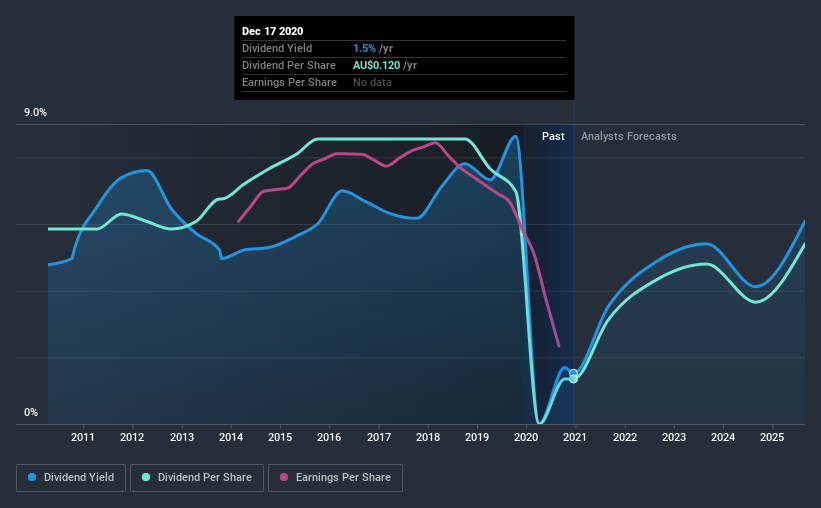How Does Bank of Queensland Limited (ASX:BOQ) Fare As A Dividend Stock?
Dividend paying stocks like Bank of Queensland Limited (ASX:BOQ) tend to be popular with investors, and for good reason - some research suggests a significant amount of all stock market returns come from reinvested dividends. Yet sometimes, investors buy a popular dividend stock because of its yield, and then lose money if the company's dividend doesn't live up to expectations.
A 1.5% yield is nothing to get excited about, but investors probably think the long payment history suggests Bank of Queensland has some staying power. Remember though, due to the recent spike in its share price, Bank of Queensland's yield will look lower, even though the market may now be factoring in an improvement in its long-term prospects. There are a few simple ways to reduce the risks of buying Bank of Queensland for its dividend, and we'll go through these below.
Explore this interactive chart for our latest analysis on Bank of Queensland!

Payout ratios
Dividends are typically paid from company earnings. If a company pays more in dividends than it earned, then the dividend might become unsustainable - hardly an ideal situation. As a result, we should always investigate whether a company can afford its dividend, measured as a percentage of a company's net income after tax. Bank of Queensland paid out 46% of its profit as dividends, over the trailing twelve month period. A medium payout ratio strikes a good balance between paying dividends, and keeping enough back to invest in the business. Besides, if reinvestment opportunities dry up, the company has room to increase the dividend.
We update our data on Bank of Queensland every 24 hours, so you can always get our latest analysis of its financial health, here.
Dividend Volatility
One of the major risks of relying on dividend income, is the potential for a company to struggle financially and cut its dividend. Not only is your income cut, but the value of your investment declines as well - nasty. For the purpose of this article, we only scrutinise the last decade of Bank of Queensland's dividend payments. The dividend has been cut on at least one occasion historically. During the past 10-year period, the first annual payment was AU$0.5 in 2010, compared to AU$0.1 last year. Dividend payments have fallen sharply, down 77% over that time.
When a company's per-share dividend falls we question if this reflects poorly on either external business conditions, or the company's capital allocation decisions. Either way, we find it hard to get excited about a company with a declining dividend.
Dividend Growth Potential
Given that dividend payments have been shrinking like a glacier in a warming world, we need to check if there are some bright spots on the horizon. Bank of Queensland's EPS have fallen by approximately 21% per year during the past five years. With this kind of significant decline, we always wonder what has changed in the business. Dividends are about stability, and Bank of Queensland's earnings per share, which support the dividend, have been anything but stable.
We'd also point out that Bank of Queensland issued a meaningful number of new shares in the past year. Trying to grow the dividend when issuing new shares reminds us of the ancient Greek tale of Sisyphus - perpetually pushing a boulder uphill. Companies that consistently issue new shares are often suboptimal from a dividend perspective.
Conclusion
To summarise, shareholders should always check that Bank of Queensland's dividends are affordable, that its dividend payments are relatively stable, and that it has decent prospects for growing its earnings and dividend. Firstly, we like that Bank of Queensland has a low and conservative payout ratio. Earnings per share are down, and Bank of Queensland's dividend has been cut at least once in the past, which is disappointing. Bank of Queensland might not be a bad business, but it doesn't show all of the characteristics we look for in a dividend stock.
It's important to note that companies having a consistent dividend policy will generate greater investor confidence than those having an erratic one. Still, investors need to consider a host of other factors, apart from dividend payments, when analysing a company. As an example, we've identified 3 warning signs for Bank of Queensland that you should be aware of before investing.
If you are a dividend investor, you might also want to look at our curated list of dividend stocks yielding above 3%.
If you’re looking to trade Bank of Queensland, open an account with the lowest-cost* platform trusted by professionals, Interactive Brokers. Their clients from over 200 countries and territories trade stocks, options, futures, forex, bonds and funds worldwide from a single integrated account. Promoted
Valuation is complex, but we're here to simplify it.
Discover if Bank of Queensland might be undervalued or overvalued with our detailed analysis, featuring fair value estimates, potential risks, dividends, insider trades, and its financial condition.
Access Free AnalysisThis article by Simply Wall St is general in nature. It does not constitute a recommendation to buy or sell any stock, and does not take account of your objectives, or your financial situation. We aim to bring you long-term focused analysis driven by fundamental data. Note that our analysis may not factor in the latest price-sensitive company announcements or qualitative material. Simply Wall St has no position in any stocks mentioned.
*Interactive Brokers Rated Lowest Cost Broker by StockBrokers.com Annual Online Review 2020
Have feedback on this article? Concerned about the content? Get in touch with us directly. Alternatively, email editorial-team@simplywallst.com.
About ASX:BOQ
Bank of Queensland
Engages in the provision of financial services in Australia.
Flawless balance sheet second-rate dividend payer.
Similar Companies
Market Insights
Community Narratives



